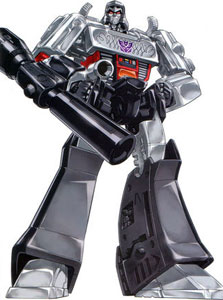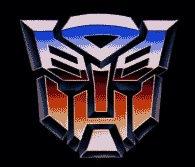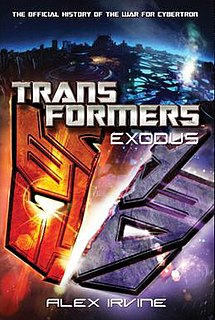
Megatron is a character from the Transformers franchise created by American toy company Hasbro in 1984, based on a design by Japanese toy company Takara. The original Megatron was the leader and warlord of the Decepticons, a fictional faction of sentient self-configuring modular extraterrestrial robotic lifeforms from the planet Cybertron. He serves as nemesis of the Autobot leader Optimus Prime.

The Decepticons are the main antagonists in the fictional universes of the Transformers multimedia franchise. They are depicted as a faction of sentient robotic lifeforms led by Megatron, identified by a purple face-like insignia. Capable of transforming into alternate forms, these are often high-tech or powerful vehicles; including aircraft, military vehicles, construction vehicles, expensive luxury or sports cars and even smaller-than-human-sized objects.

Starscream is a fictional character in the many continuities in the Transformers franchise. He is one of the most frequently occurring characters in the Transformers fictional work, appearing in almost all continuities of the Transformers franchise. Generally depicted as a deadly Decepticon who transforms into a jet fighter and who serves as Megatron's second-in-command, Starscream's defining trait is his desire to supplant Megatron as Decepticon leader.

Autobots are a team of sentient mechanical self-configuring modular robotic lifeforms from the planet Cybertron led by Optimus Prime, and the main protagonists in the universe of the Transformers, a collection of various toys, cartoons, movies, graphic novels, and paperback books first introduced in 1984. The "Heroic Autobots" are opposed by the "Evil Decepticons". Both Autobots and Decepticons are humanoid robots that can transform into machines, vehicles and other familiar mechanical objects, as well as mimic organic lifeforms (Dinobots). Autobots typically transform into regular cars, trucks, or other road vehicles (automobiles) but some are aircraft, military vehicles, communication devices, weapons, and even robotic animals. These Autobots are often grouped into special "teams" that have the suffix "-bot" at the end, such as in Dinobot.

Cybertron is a fictional planet, the homeworld of the Transformers in the various fictional incarnations of the metaseries and toyline by Hasbro. In the Japanese series, the planet is referred to as "Cybertron" pronounced as Sabertron セイバートロン Seibātoron. Cybertron is populated by mechanical self-configuring modular lifeforms of variable size who can transform into all kinds of machinery. These are called Cybertronians, or Transformers.
Galvatron is a name adopted by several fictional characters in the Transformers robot superhero franchise. He is usually the recreated form of Megatron, the Decepticon leader; however, it has been used for separate and unrelated characters, most notably the main villain of the anime series Beast Wars II, and the character from the more recent IDW Publishing G1 series.
Shockwave is the name of several fictional characters in the Transformers robot superhero franchise. Throughout his incarnations, he is usually distinguished by a laser cannon instead of one of his hands and his distinctive face, which is featureless save for a single robotic eye. He is also commonly portrayed as a cold, emotionless Decepticon that serves as Megatron's "mad scientist". Due to issues with Hasbro's trademark of the name Shockwave, some products were also released under the name Shockblast or "Shockblast the Great".

Optimus Primal is a fictional character from the Transformers toyline, and the leader of the Maximal forces and the protagonist in the Beast Wars television series. He is sometimes called Optimal Optimus. The name Optimus Primal was given to Optimus Prime during the initial run of the Beast Wars toy line, before it was decided that Optimus Primal was a separate character.

Within the narrative of the fictional Transformers universe, a spark is usually the "soul" of a Transformer. Likewise, the AllSpark is an ancient artifact or object capable of creating new Transformer life by bestowing machinery with sparks. The term "AllSpark" was created by writer Robert N. Skir, who responded to a fan question about the TV series Beast Machines July 21, 1999, web page. Skir explained that the Beast Machines entity called The Oracle was actually the AllSpark, consisting of "the spark of every transformer who has ever lived, or ever will live". In a November 6, 1999, web page, Skir clarified that the Matrix was something called the AllSpark and was "made up of every Spark that ever was, and every Spark that ever will be".

Optimus Prime, known in Japan as Convoy, is a fictional character from the Transformers franchise. He is a Cybertronian, an extraterrestrial species of sentient self-configuring modular robotic lifeforms, a synergistic blend of biological evolution and technological engineering. In almost every version of the mythos, Optimus is the leader of the Autobots, a faction of Transformers who are rivals of the Decepticons, another faction. He is defined by his strong moral character and is almost always portrayed as the primary hero of the story, opposing the evil Decepticon leader Megatron.

The Predacons are usually depicted as antagonists in the fictional continuities of the Transformers storyline and related comics and cartoons. Usually, they have a relation to the Decepticons, the more prominent antagonists of the series, be they a subgroup, their successors, or even their creators. They are the enemies of the Maximals and even sometimes their predecessors, the Autobots, depending on the continuity. The villains take many forms, and have many different origins and stories across the numerous different Transformers media, but in almost all incarnations, they are led by a character who is either Megatron, or Predaking, an ancient Predacon leader. They are typically represented by the facial insignia they all wear. In the Japanese version of the franchise, the Predacons are called Destrons or Animatrons. The one exception to this naming convention is Car Robots, where the overall name of the Robots in Disguise villain faction is Destronger.

Transformers: Animated is an American animated television series based on the Transformers toy line. It was produced by Cartoon Network Studios and Hasbro and animated by The Answer Studio, Mook Animation, and Studio 4°C (shorts). The series debuted on Cartoon Network on December 26, 2007, and ended on May 23, 2009. In Japan, the show debuted on April 3, 2010, on both TV Aichi and TV Tokyo.

Transformers: Generations is a 2010 toy line by Hasbro. Much like the preceding Universe toy line, Generations covers different eras of Transformers; here, the toys are based upon characters from Generation 1 and the video game Transformers: War for Cybertron, as well as the Transformers comics by IDW Publishing. The figures consist of new molds as well as redecos of ones originally used in the Classics and Universe lines. These Deluxe Class figures stand at about 5.5 to 6 inches tall and feature intermediate to moderate transformation levels.

Transformers Prime Beast Hunters: Predacons Rising is a 2013 American computer animated action adventure television film that concludes the Transformers: Prime television series. It was first broadcast on Hub Network on October 4, 2013. After the Autobots victory on Earth, Unicron returns in possession of Megatron's body with the intent on destroying Cybertron, forcing Autobots, Decepticons, and Predacons to form an unlikely alliance to counter this threat.












